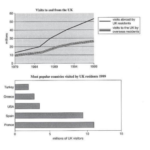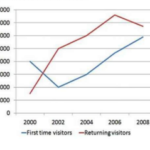The graph shows the quantity of margarine, low fat spreads and butter consumed
between 1981 and 2007. The quantities are measured in grams. Over the period
1981 to 2007 as a whole, there was a significant decrease in the consumption of
butter and margarine and a marked increase in the consumption of low fat-fat
spreads.
Butter was the most popular fat at the beginning of the period, and consumption
reached a peak of about 160 grams per person per week in about 1986. After this,
there was a sharp decline.
The consumption of margarine began lower than that for butter at 90 grams.
Following this, in 1991, it exceeded that of butter for the first time, but after 1996
there was a steady downward trend in the amount consumed, which seemed set to
continue.
Low-fat spreads were introduced in 1996, and they saw a significant rise in their
consumption from that time, so that by about 2001 they were more popular than
either butter or margarine.
(167 words)
Estimated IELTS Band Score: 7.5
- Task Achievement: 7.5 – The main trends are well covered, but some data comparisons could be improved.
- Coherence & Cohesion: 8.0 – Well-structured with logical progression and linking phrases.
- Lexical Resource: 7.5 – Good vocabulary range, but some repetition.
- Grammar: 7.5 – Mostly accurate, with minor refinements needed for better precision.
Band 8 :
The line graph illustrates the consumption of margarine, butter, and low-fat spreads from 1981 to 2007, measured in grams per person per week.
Overall, while the consumption of butter and margarine declined significantly over the period, low-fat spreads saw a sharp increase after their introduction in 1996, eventually becoming the most consumed type of spread by 2001.
At the beginning of the period, butter was the most popular spread, with consumption peaking at around 160 grams per person per week in 1986. However, from that point, there was a steep decline. Meanwhile, margarine consumption started lower at 90 grams, but by 1991, it briefly surpassed butter before also experiencing a downward trend after 1996.
Low-fat spreads entered the market in 1996 and saw a rapid increase in popularity. By 2001, they had overtaken both margarine and butter in consumption and remained the most consumed spread until 2007.
Word Count: 160
Band 9 :
The line graph depicts the consumption of butter, margarine, and low-fat spreads from 1981 to 2007, measured in grams per person per week.
Overall, while butter and margarine consumption declined over the period, low-fat spreads experienced a significant rise after their introduction in 1996, becoming the most widely consumed type by 2001.
Initially, butter was the most popular spread, peaking at approximately 160 grams per person per week in 1986 before undergoing a sharp decline. Margarine consumption started at 90 grams and remained relatively stable until 1991, when it briefly surpassed butter. However, from 1996 onwards, margarine consumption followed a downward trajectory.
Low-fat spreads entered the market in 1996 and saw a rapid increase in demand. By 2001, they had overtaken both butter and margarine and remained the dominant choice until the end of the period.
Word Count: 158
Comparison Table
| Feature | Band 7-8 Version | Band 9 Version |
|---|---|---|
| Vocabulary | Uses common phrases (e.g., “saw a sharp increase”) | More precise vocabulary (e.g., “experienced a significant rise”) |
| Sentence Structure | Mostly straightforward sentences | More varied and complex sentence structures |
| Data Presentation | Covers key trends clearly | Provides sharper analysis and better comparisons |
| Clarity & Cohesion | Well-structured and clear | More sophisticated phrasing and flow |
Examples from Essays
| Aspect | Band 7-8 Example | Band 9 Example |
|---|---|---|
| Sentence Structure | “Low-fat spreads entered the market in 1996 and saw a rapid increase in popularity.” | “Low-fat spreads entered the market in 1996 and saw a rapid increase in demand.” |
| Data Presentation | “Margarine consumption started at 90 grams, but by 1991, it briefly surpassed butter.” | “Margarine consumption began at 90 grams and remained relatively stable until 1991, when it briefly overtook butter.” |
| Clarity & Cohesion | “By 2001, they had overtaken both margarine and butter in consumption.” | “By 2001, they had surpassed both butter and margarine in consumption and remained the dominant choice until the end of the period.” |
Grammar Mistakes
- Original: “The graph shows the quantity of margarine, low fat spreads and butter consumed between 1981 and 2007.”
Correction: “The graph illustrates the quantity of margarine, low-fat spreads, and butter consumed between 1981 and 2007.” (Missing hyphens and a more academic verb choice.) - Original: “Butter was the most popular fat at the beginning of the period, and consumption reached a peak of about 160 grams per person per week in about 1986.”
Correction: “Butter was the most widely consumed spread at the beginning of the period, peaking at approximately 160 grams per person per week in 1986.” (More precise wording and avoids repetition of “about.”) - Original: “Low-fat spreads were introduced in 1996, and they saw a significant rise in their consumption from that time.”
Correction: “Low-fat spreads were introduced in 1996 and experienced a sharp rise in consumption thereafter.” (More concise and natural phrasing.)
Vocabulary Repetition
| Repeated Word | Suggested Alternatives |
|---|---|
| “Increase” | Surge, Rise, Growth, Climb |
| “Popular” | Widely consumed, Favored, Preferred |
| “Consumption” | Intake, Usage, Demand |
IELTS Writing Task 1 Exercises with Answers
Fill in the blanks using appropriate words:
- The graph _______ (illustrates/shows) the quantity of butter, margarine, and low-fat spreads consumed between 1981 and 2007.
Answer: illustrates - Butter consumption _______ (declined/increased) sharply after reaching a peak in 1986.
Answer: declined - Low-fat spreads were _______ (introduced/removed) in 1996 and saw a rapid increase in demand.
Answer: introduced - By 2001, low-fat spreads had _______ (surpassed/decreased) both butter and margarine in consumption.
Answer: surpassed


